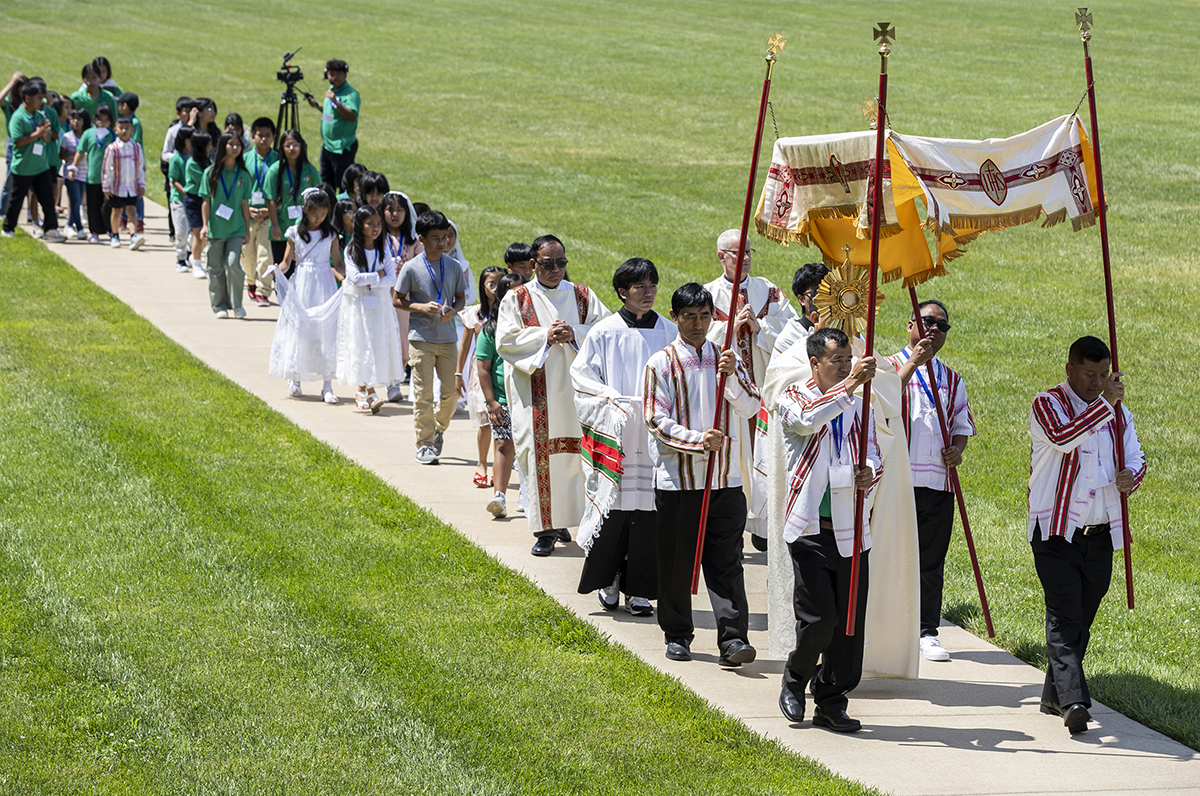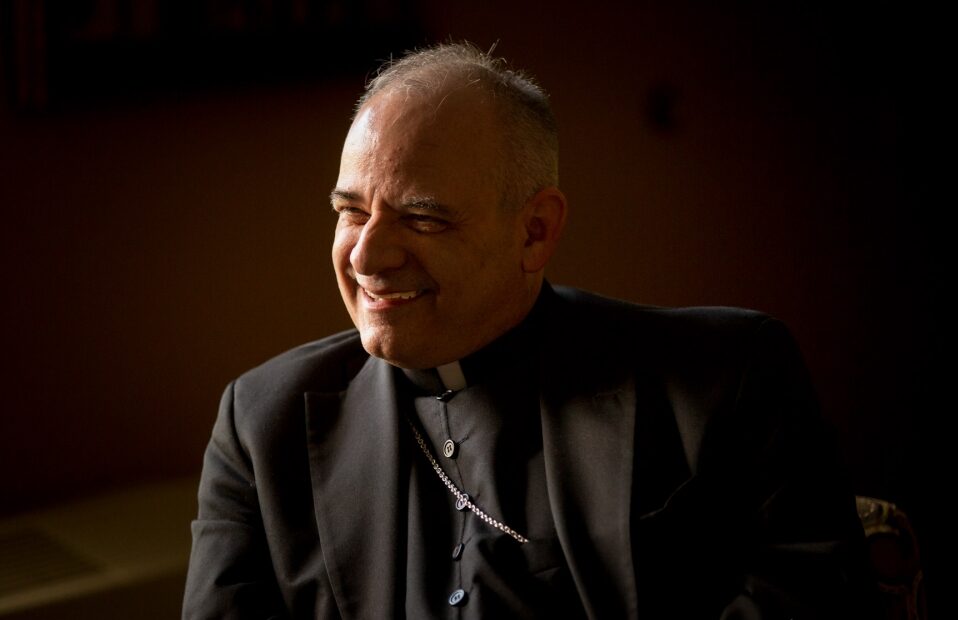Cardinal virtues are foundation of new house system for fifth-graders at Christ Prince of Peace

Fifth-graders earn points for living examples of the virtues
With mascots and saintly superheroes as their guides, fifth-graders at Christ Prince of Peace School in Manchester are learning how to live the cardinal virtues in a new house system this school year.

Sarah Mensinger has split her class into four houses, representing the virtues of prudence, justice, fortitude and temperance. Students earn points for living examples of the virtues. Each house also adopted two saints who exemplify those virtues and came up with an animal mascot, house chant and hand signal.
“What are the cardinal virtues?” Mensinger recently asked her students, adding that they’re all interconnected.
“They’re examples of God and how we should live our lives every day,” student Maddie Selkrik replied.
“Virtue is a habitual and firm disposition to do good,” according to the Catechism of the Catholic Church. “The human virtues are stable dispositions of the intellect and the will that govern our acts, order our passions and guide our conduct in accordance with reason and faith” (Catechism of the Catholic Church, 1833-34).
Students shared examples of how they’re able to earn points for their house, such as cheering on a classmate during a kickball game, helping someone to learn how to play the game and cleaning up the classroom without being asked.
Cormac O’Keefe recently earned 20 points for his house — fortitude — by including everyone in a football game and helping to tie a younger student’s shoes.
Fortitude’s house mascot, a lion, represents how to “choose what is right, and to know to do what is right,” Cormac said. “Even if it’s not popular, you choose the right thing.”
Other house mascots include a buffalo, representing justice, which has the ability to be gentle but firm and move ahead; a camel, representing temperance, which remains undistracted by outside influences and stores water for the long journey; and a squirrel for prudence, as an example of an animal that plans ahead, such as saving nuts for the winter.
Several house chants also were created to keep students in the spirit, reminding them of the importance of their actions. Members of the fortitude team, for example, raise their fists in the air while shouting, “be courageous!”

Students shared their reasons why they think the Church has given us the cardinal virtues. Isabella Thurmond said virtues help us to be closer to God and know to be closer to God and to know what’s right. Eddie Metzner said he believes they help us to stay on track and not be distracted by things that lead us away from God.
Mensinger, the fifth-grade teacher, said the house system continues to be a work in progress, and so far she’s enjoyed seeing how students are learning more deeply about the cardinal virtues and how they can live them out in everyday situations.
>> The Four Cardinal Virtues
Prudence disposes practical reason to discern our true good in every circumstance and to choose the right means of achieving it; “the prudent man looks where he is going.” “Keep sane and sober for your prayers.” Prudence is “right reason in action,” writes St. Thomas Aquinas, following Aristotle. It is not to be confused with timidity or fear, nor with duplicity or dissimulation. It is called auriga virtutum (the charioteer of the virtues); it guides the other virtues by setting rule and measure. It is prudence that immediately guides the judgment of conscience. The prudent man determines and directs his conduct in accordance with this judgment. With the help of this virtue we apply moral principles to particular cases without error and overcome doubts about the good to achieve and the evil to avoid.
Justice consists in the constant and firm will to give their due to God and neighbor. Justice toward God is called the “virtue of religion.” Justice toward men disposes one to respect the rights of each and to establish in human relationships the harmony that promotes equity with regard to persons and to the common good. The just man, often mentioned in the Sacred Scriptures, is distinguished by habitual right thinking and the uprightness of his conduct toward his neighbor. “You shall not be partial to the poor or defer to the great, but in righteousness shall you judge your neighbor.” “Masters, treat your slaves justly and fairly, knowing that you also have a Master in heaven.”
Fortitude ensures firmness in difficulties and constancy in the pursuit of the good. It strengthens the resolve to resist temptations and to overcome obstacles in the moral life. The virtue of fortitude enables one to conquer fear, even fear of death, and to face trials and persecutions. It disposes one even to renounce and sacrifice his life in defense of a just cause. “The Lord is my strength and my song.” “In the world you have tribulation; but be of good cheer, I have overcome the world.”
Temperance moderates the attraction of pleasures and provides balance in the use of created goods. It ensures the will’s mastery over instincts and keeps desires within the limits of what is honorable. The temperate person directs the sensitive appetites toward what is good and maintains a healthy discretion: “Do not follow your inclination and strength, walking according to the desires of your heart.” Temperance is often praised in the Old Testament: “Do not follow your base desires, but restrain your appetites.” In the New Testament it is called “moderation” or “sobriety.” We ought “to live sober, upright, and godly lives in this world.”
Source: Catechism of the Catholic Church
With mascots and saintly superheroes as their guides, fifth-graders at Christ Prince of Peace School in Manchester are learning how to live the cardinal virtues in a new house system this school … Cardinal virtues are foundation of new house system for fifth-graders at Christ Prince of Peace
Subscribe to Read All St. Louis Review Stories
All readers receive 5 stories to read free per month. After that, readers will need to be logged in.
If you are currently receive the St. Louis Review at your home or office, please send your name and address (and subscriber id if you know it) to subscriptions@stlouisreview.com to get your login information.
If you are not currently a subscriber to the St. Louis Review, please contact subscriptions@stlouisreview.com for information on how to subscribe.







